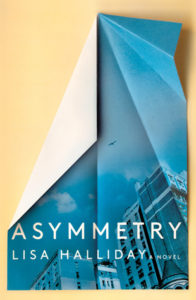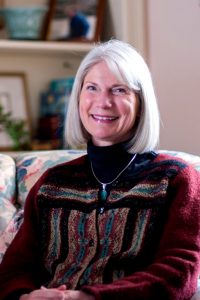Asymmetry
Halliday’s first novel opens as twenty-five-year old Mary Alice, an aspiring writer, meets a successful, aging novelist on a park bench and begins a relationship with him. Halliday doesn’t try to conceal the fact that the situation is loosely based on her own relationship with the author Philip Roth when she was in her twenties. Mary Alice’s affair with Ezra is mutually beneficial: She calls him a “craddlerobber,” he calls her a “graverobber;” they watch baseball on TV together; she fetches pills and ice cream as his health deteriorates, he pays off her college loans, gives her bags of books to read, and corrects her pronunciation of Albert Camus’ last name. Inserted between “Folly,” the section detailing their two-year relationship, and a short coda in which Ezra looks back on his life years later is “Madness.” This section seems to be the completely unconnected story of Amar, a dual U.S. and Iraqi citizen, on his way to Iraq to see his brother with a stop in London to visit Alastair, a British journalist compelled to cover war-torn countries. Amar is caught both emotionally (between the two countries to which he holds passports) and physically (in London’s passport control), his detention somehow connected to his friend Alastair. When the realization dawns that Mary Alice and Amar are indeed connected, the urge to reread and piece together the nearly-invisible clues is almost irresistible. It is ingenious, Halliday’s technique of telling her story by leaving a key chunk of it untold. She packs whole worlds into bits and pieces of dialogue and her research on the part of the novel set in Iraq (a country she never visited) is astonishing. Asymmetries pile high in this very writerly book, not least of them the question that confronts both Mary Alice and Alastair: How far will you go for a story? Unfortunately, the sense of disjointedness doesn’t disappear when the thread that connects “Folly” and “Madness” becomes clear. I was left proud of myself for having solved the structural puzzle but still feeling that I’d just read two short stories rather than a novel.
—
Connie Nordhielm Wooldridge, Author

- Just Fine They Way They Are (Calkins Creek, March 1, 2011)
- The Brave Escape of Edith Wharton (Clarion Books, 2010)
- Thank You Very Much, Captain Ericsson! (Holiday House, 2005; Berndtsdotter Books, 2012)
- When Esther Morris Headed West (Holiday House, 2001)
- The Legend of Strap Buckner (Holiday House, 2001)
- Wicked Jack (Holiday House, 1995)
Speaker / Presenter
Connie is an experienced speaker and presenter who enjoys sharing her passion for writing and her experience as a writer with readers and writers of all ages. She has presented to students, community, civic and professional organizations, writing groups, library audiences, and seniors – wherever book lovers gather!
>> More Information About Connie Speaking and Presenting

